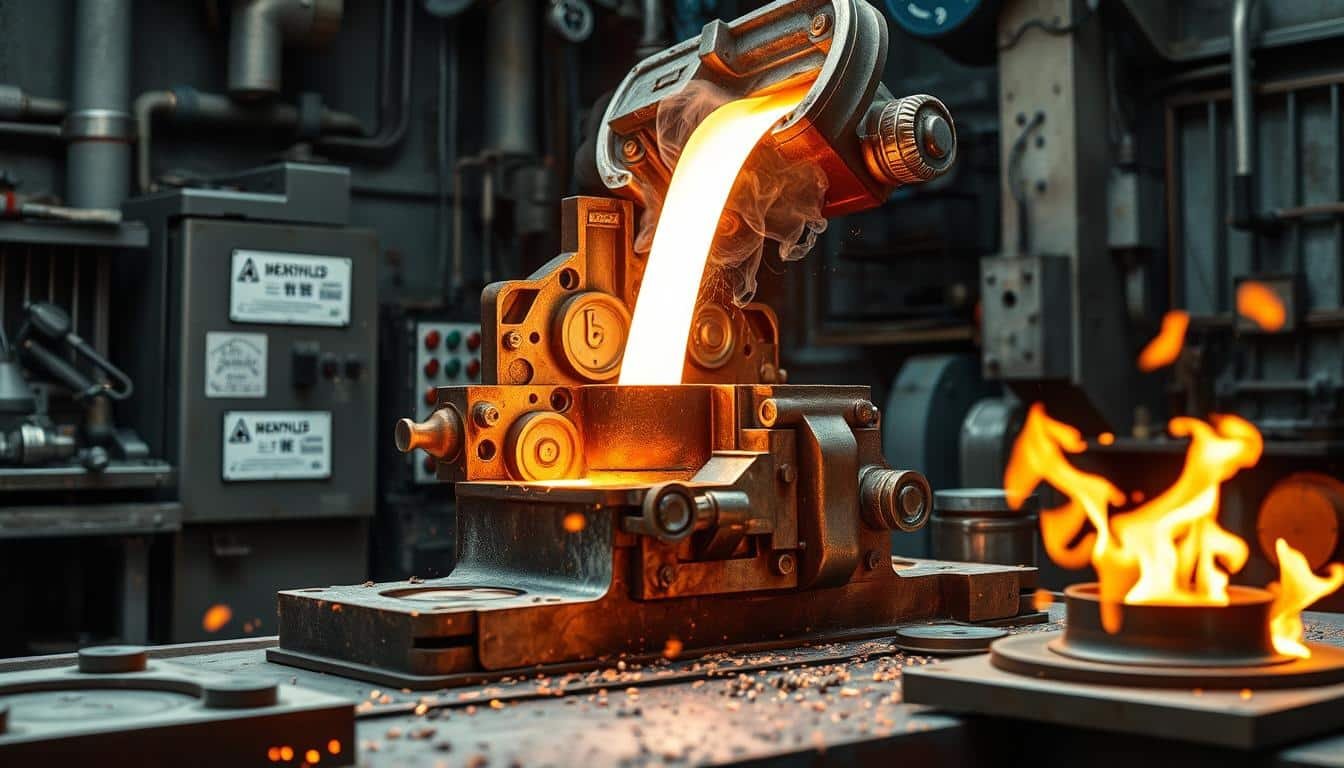Die casting can cut component costs by up to 80%. This ancient technique has transformed mass production across many industries. It’s vital for manufacturers and artists to master this process12.
Get ready to explore the world of diecast alloys and precision manufacturing. This guide will help you understand die casting techniques. It’s perfect for both pros and beginners.
Die casting creates high-quality, durable parts with great accuracy2. It’s used to make everything from tiny electronics to big car parts. The process uses materials like aluminum, magnesium, and zinc alloys2.
Key Takeaways
- Die casting can reduce component costs significantly
- The process is ideal for high-volume, precision part production
- Various materials and methods are available for different applications
- Die casting is widely used in automotive, aerospace, and electronics industries
- Understanding design considerations is crucial for optimal results
- Die casting offers excellent dimensional accuracy and part consistency
Understanding the Fundamentals of Metal Die Casting
Metal die casting is a versatile manufacturing process. It creates intricate parts with exceptional precision. Molten metal is forced into a mold cavity under high pressure.
What is Die Casting and Its Historical Development
Die casting began in the mid-19th century for the printing industry. It quickly spread to automotive, aerospace, and electronics sectors. This process revolutionized metal component production3.
Die casting produces parts with thin walls and low weight. It ensures high integrity and close dimensional control. These features make it ideal for many engineering applications4.
Types of Die Casting Methods
Two main types of die casting methods exist: hot chamber and cold chamber. Hot chamber suits metals with low melting points. It uses lower pressure.
Cold chamber is for metals with high melting temperatures. It requires higher pressure3. These methods offer flexibility in diecast machine operations.
Common Die Casting Materials and Alloys
Die casting mainly uses non-ferrous metals like aluminum, zinc, and magnesium3. Each material has unique properties for specific applications. Aluminum alloys are popular for their lightweight properties.
Aluminum can create complex shapes with thin wall sections. The material choice greatly affects diecast product finishing and overall quality.
“Die casting can produce castings with good strength and high production rates compared to other casting processes.”
Die casting is used in automotive, engine blocks, and agricultural equipment. It shapes modern manufacturing across various industries4. Explore more about this versatile process.
Discover how die casting continues to innovate manufacturing techniques. Learn about the die casting process and its applications to expand your knowledge.
How to Diecast Metal: Step-by-Step Process

Die casting creates intricate metal parts by injecting molten metal into a mold cavity. This manufacturing process is versatile and widely used. Let’s explore the steps involved in die casting metal.
Creating a pattern and mold is the first crucial step. It determines the final product’s shape and quality. Choosing the right metallic alloy comes next.
Common die casting alloys include aluminum, zinc, and magnesium. Each offers unique properties like corrosion resistance and strength5.
After selecting the alloy, it’s melted and poured into the mold. This uses one of three main processes: gravity, pressure, or aluminum die-casting6.
High-pressure die-casting allows for better dimensional accuracy and smoother finishes6. Once injected, the metal cools and solidifies. The casting is then removed and finished.
Safety is crucial throughout the process. Protective clothing, proper ventilation, and fire safety protocols are essential. These measures protect workers and ensure a smooth operation.
| Die Casting Process | Best Used For | Key Advantage |
|---|---|---|
| Hot-Chamber | Zinc and some magnesium alloys | Faster cycle times |
| Cold-Chamber | Metals with high melting points (e.g., aluminum) | Better for larger parts |
| Injected Metal Assembly | Complex assemblies | Combines multiple components in one step |
Die casting shines in large-scale production, despite high initial tooling costs. It offers net shape production and minimal secondary operations.
The process allows high-speed manufacturing of complex geometries5. This makes it a go-to choice for many industries.
Design Considerations and Best Practices for Die Casting
Die casting design requires careful planning and attention to detail. By understanding key principles, you can optimize designs for better results. Let’s explore crucial aspects of die casting design.
Optimizing Wall Thickness and Weight Reduction
Wall thickness is vital in die casting. For aluminum, aim for 1.016 – 2.032 mm thickness. Zinc allows for 0.381 – 0.889 mm, while magnesium ranges from 1.016 – 2.54 mm7.
Proper thickness ensures uniform metal flow and prevents defects. Castings typically shrink 0.4-0.6% in volume, aiding product ejection8.
Draft Angles and Tolerance Requirements
Draft angles are crucial for easy part removal. Outside walls need small drafts, while inside walls require larger ones8.
Design fillets and radii no less than 1 mm to avoid sharp corners. Use larger radii for highly loaded areas7. These elements improve metal flow and prevent turbulence during injection.
Surface Finish Options and Treatments
Die casting offers various surface finish grades, from Utility (Grade-1) to Superior (Grade-5)7. Choose based on your product’s needs and budget.
Post-casting treatments like anodizing or powder coating can boost durability and appearance. Adding features through post-machining increases lead time and cost7.
Quality Control Measures
Robust quality control is key to managing diecast defects. Focus on parting line design, aiming for minimal visibility and appropriate thickness7.
Incorporate ribs to increase structural soundness and facilitate metal flow8. By focusing on these aspects, you’ll improve diecast quality and produce superior parts.
FAQ
What is die casting?
What are the main types of die casting methods?
What materials are commonly used in die casting?
What are the steps involved in the die casting process?
How important is mold design in die casting?
What are some important safety measures in die casting?
How can I optimize my die casting design?
What are some common surface finish options for die cast parts?
How can I ensure quality control in die casting?
What is Design for Manufacturability (DFM) in die casting?
Source Links
- Die Cast Design | Aluminum Die Casting Design Guide – https://www.dynacast.com/en/knowledge-center/blog/beginners-guide-to-die-casting
- Die Casting Overview: Process, Materials | Xometry Pro – https://xometry.pro/en/articles/die-casting-overview/
- What is Die Casting? Processes, Materials, Applications, Costs – https://www.rapiddirect.com/blog/what-is-die-casting/
- A Complete HandBook For Metal Die Casting – https://www.academia.edu/31904534/A_Complete_HandBook_For_Metal_Die_Casting
- Die Casting | Die Casting Process Overview | Dynacast – https://www.dynacast.com/en/discover-dynacast/die-casting
- The Die Casting Process in 5 Steps – How it Works – Lupton & Place – https://www.lupton-place.co.uk/news/die-casting-process/
- Design Tips for Die Casting: Design Guidelines | Xometry Pro – https://xometry.pro/en-eu/articles/die-casting-design-tips/
- Aluminum Die Casting Design Guide: 9 Top Considerations – https://www.gabrian.com/aluminum-die-casting-design-guide/








While the historical development is appreciated, can we focus more on the actual hands-on process of diecasting metal?
Surely practical knowledge trumps historical trivia. Lets delve into the diecasting process!
Really appreciate the historical aspect in this guide! But, could we delve a bit further into the different die casting methods?